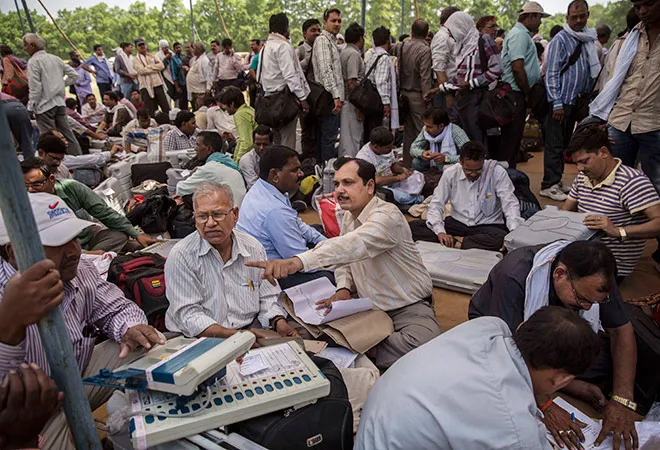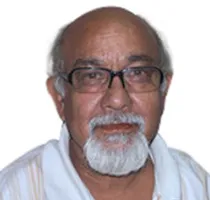
The move of the top BJP-RSS leadership to field saffron-clad Sadhvi Pragya Singh Thakur, an accused in the Malegaon bomb blast case, from the Madhya Pradesh capital Bhopal that goes to polls on May 12 is not a routine or ordinary election time decision. She is fighting against one of Congress’s top leaders, Digvijay Singh, a former Chief Minister. The outcome of this electoral battle is going to define the shape of the Indian politics for the coming decades.
After sustained deliberations between the top RSS (Rashtriya Swyamsevak Sangh) leadership and the duo of Prime Minister Narendra Modi and BJP chief Amit Shah, it was decided that former Digvijay Singh should be challenged by Pragya Singh who is an icon of the Hinduatva forces.
The BJP has been winning the Bhopal Lok Sabha seat since 1989 and the Congress has been on the losing wicket. In 2014, the BJP’s candidate, Alok Sanjar, had polled 7.15 lakh votes, accounting for more than 63% of the total votes polled. The Congress candidate, P C Sharma, had just managed 3.44 lakh votes, which was just 30% of the share.
By fielding Digvijay Singh, the Congress leadership, including MP Chief Minister Kamal Nath, has taken a determined step to end the BJP hold on Bhopal -- a move that rattled the combined RSS-BJP leadership, particularly because the State capital and the region around it has been the Sangh laboratory for all these years. The BJP has been winning Lok Sabha seats in this region for decades.
Sensing a possible defeat against a formidable opponent who is also one of the most prominent and high-profile leader of the Congress in the State, the BJP has gone for one of the most hardcore Hinduatva icon, who is known for her fiery oratory. Pragya Singh is an accused in the Malegaon bomb blast case that took place in 2008 in which six persons were killed and over hundred were injured.
In the RSS-BJP calculations, Digvijay Singh is a formidable opponent ever since he underwent an image makeover through his six-month-long ‘Narmada Yatra’. River Narmada that flows through the State is considered pious and holy by people at large. By undertaking a foot march along the river Narmada, Digvijay Singh had succeeded in projecting himself as a pious ‘Hindu’ who follows the path of Sanatan Dharma that is being followed by majority of Hindus for centuries. At the same time, Digvijay Singh had also made abundantly clear that he was opposed to Hindutva forces that was being propagated by the RSS outfits, including the BJP.
The BJP’s move came in the background of its defeat in the 2018 assembly elections when it lost power after ruling the State for 15 years. In full realization that the party’s goal of repeating its electoral performance of 2014 general elections when it won 27 out of the total 29 Lok Sabha seats in the State was impossible, the BJP-RSS decided to turn the battle into Hinduatva versus secular Congress that has been appeasing Muslims all these decades.
Making Pragya Singh the BJP candidate is part of the electoral strategy that was readied in the background of the deteriorating economic scenario, falling industrial production, growing unemployment and rising crisis of agricultural distress. Nationalism, emanating from Hinduatva that was the caretaker, preserver and protector of majoritarian interests, was the new narrative that was clearly defined in the party’s manifesto. It is an aggressive and muscular nationalism that believes more in confrontation than in reconciliation.
The BJP thought it was all the more necessary to send a hard Hinduatva message because of the danger of losing heavily in the Hindi heartland was looming large. The BJP had won more than 190 Lok Sabha seats in 2014. Bhopal provided an excellent opportunity to the BJP leadership to send the message across the country in general and to Hindi heartland States in particular. While releasing the BJP manifesto, it had been made clear that the party would ensure that there was no interference by the executive or judiciary in matters of faith like it had been done in Sabarimala temple case in Kerala where the apex court had allowed the entry of women of all ages into the temple that was hitherto possible only for 50 plus age women.
The narrative on Pulwama and the Indian Air Force (IAF) strike on the terrorist camps in Balakot inside Pakistan was part of the nationalism discourse that has been developed to divert popular attention from the real issues of rural poverty, agricultural distress and joblessness.
The Prime Minister has defended the fielding of Pragya Singh saying she was a symbolic answer to all those who falsely labelled the rich Hindu civilization as “terrorist” and asserted that “this symbol will prove costly for the Congress”.
Over the fortnight, a bitter and nasty no-holds barred battle is going to be fought between the two rival camps. No efforts are going to be spared.
The move is an experiment to decide the future shape of the politics. A BJP victory would embolden the Sangh policy makers to embark upon the path with determination to undermine the Constitution that guarantees religious freedom and right to life along with freedom of expression etc. A defeat of Sadhvi Pragya Singh in Bhopal would result in a postponement of the Hinduatva path for till an opportune time later on.
The trial of strength by the two rival parties is ideological in nature. It is, indeed, a historical election in which the two national parties are in direct contest to determine the future course of Indian politics for years to come.
The views expressed above belong to the author(s). ORF research and analyses now available on Telegram! Click here to access our curated content — blogs, longforms and interviews.




 PREV
PREV


